|

Read this page to see information on what 3D and 4 axis CNC are all about its not the same as 2d or 2.5D puzzles which are commonly refered to as 3D puzzles the ones you see made from sheet stock on the rest of our website its a whole new world of CNC that uses different software and different tooling so its important for you to know what these differences are.
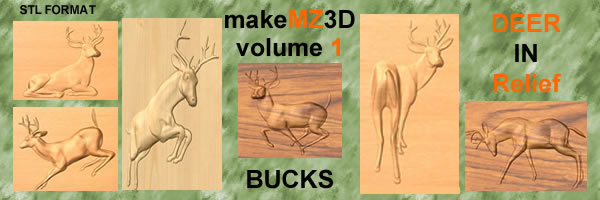
NFORMATION BELOW FOR THOSE WHO WISH TO CUT IN 3D
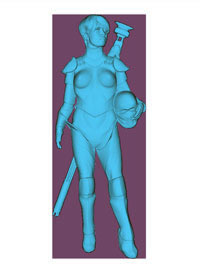 
3D Routing & Carving with CNC Machines
CNC Routing Machines, such as the Probotix V90 Fireball,
can accomplish 3D work with little confusion or effort.
With a little of the correct knowledge it can be done but mostly with the correct software.
MakeCNC uses the Probotix V90 Fireball and programs like Meshcam and CNC wrapper for all of its 3d projects and prototyping work as well. So examples on this website will be assumed to be made with those products but should work fine with almost any CNC router.
We have written this article to give you an introduction to 3D CNC and 3D relief Carving using CNC Routers and to show you how
to work with 3D features with whatever type of software application you use in your work.
Not everyone uses the same methods and/or software for 3D Machining but understanding the different
choices will help you choose a method that's right for you.
Some History with 2D and 2.5D
All 3 Axis and 4 Axis CNC machines are capable of doing 3D in its fullest. 3 Axis
interpolation is a term which means that moves made on the machine are smooth in
3D space when using diagonals and curves.
Some earlier CNC machines were not capable of 3D carving because either their Z axis
moved only when X and Y were not moving or they only had a single up and down
position. These were called 2 or 2.5D robotic tools.
The 2D or 3D terms now refer to what the design software can do rather than the
designing side of the project.
2D is when you only have the flat outline of an object or picture you would like to
cut out. Once you add straight up and down movements of the CNC cutter in and out
of the material you are using this is called 2.5D. Your project starts off as 2D
but can change to 2.5D during the process of your tool path creation. This occurs when
you assign a depth for the CNC machines tool motion. The software then generates the
part file. The instructions first move the CNC tool to the assigned cutting depth in the
Z axis and then moves the cutter through the XY tool path at that depth. The instructions
then returns the CNC tool to the starting height with a straight pull up.
So in essence, when the file is finished the cutting tool has actually moved in three
dimensions...the X, Y and Z, but all the X and Y axis motion is still in a single plane
and the X and Y actually stop when the Z axis plunges or pulls up. This makes it 2D.
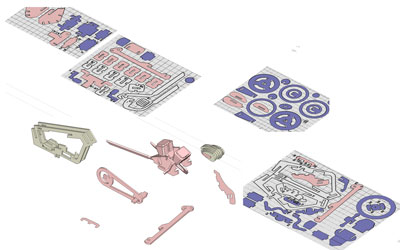
When you are designing CNC in 2.5D the CAD/CAM Software is pretty straightforward because
you don't have to worry about visualizing your part in 3 dimensions unless your parts are put together to create a 3d object after they are cut, of course.
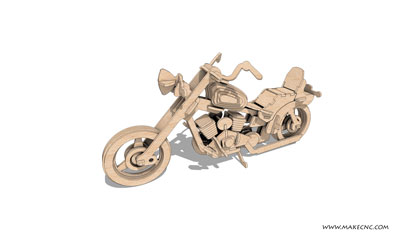
CAD/CAM Software works very well for projects where you cut parts out of sheet material.
It also works well where you are pocketing areas.
All of this type of cutting can be done in different cutting planes after dropping to a cutting
depth.
Return to Top of Page
V-Carving... That might be the Ticket !
V-Carving is commonly thought of as a 2.5D design process. The technique used in this uses
CNC motion with a v-shaped cutter which gives a chiseled look to lettering and other shapes
that ordinarily would have been carved by hand. This is also known as chip carving.
This is called 2.5D even though the design you are working with is still 2D in nature and
the CNC movements that create the chisel effect involve full 3D, which contains the
simultanuous motion of the X, Y and Z motion of the cutter.
You can definately add a spectacular look to your sign work or woodcarvings with V-Carving.
It's very easy to do because the layout process is still in 2D so it's easy to create designs
and makes carving letters much faster. Below is an example of a Vcarved logo and a fish platter that used V carving , profile cutting and pocketing.
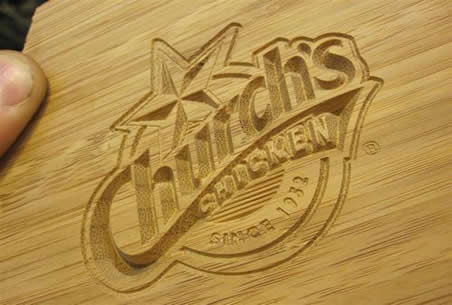
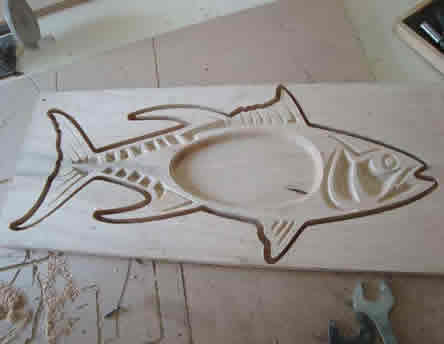
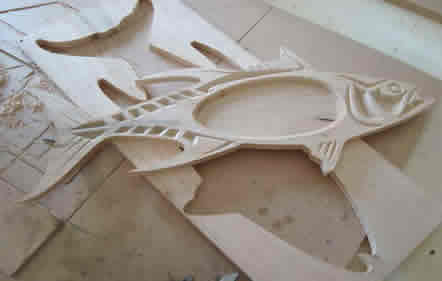
Designing Fully within 3D and Milling with Your CNC Machine

For your CNC machine to be able to cut in Full 3D it has to be a minimum of a 3 Axis machine.
A 3 Axis machine has simultaneous cutting motion in the X, Y and Z axes.
When cutting in 3D your CNC cutter tip follows paths in 3D curves or angles when carving
complex shapes into material. 3D takes full advantage of your CNC tools capabilities to
produce contoured shapes cut to your specifications. You have almost unlimited shapes
and contours that you can machine and you can mold them to be uniquely your own designs.
If you are going to work in 3D you need to separate the process of designing from the actual
tool path generation process. There are separate software programs for each.(MeshCam) There are only
a few programs that provide both capabilities.(MeshCam ART) 3D designs are used in the world for lots of
other purposes than just CNC cutting so there are many approaches for the design process.
makecnc will be creating some pages and videos over time to focus more fully on some of these more advanced concepts and processes. Return regularly and look for updates.
3D Machining Process
Return to Top of Page
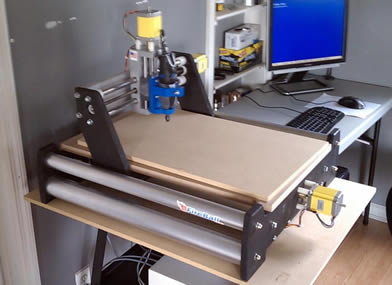
3D CAD
First you must create the shape or concept you wish to use.
Then you need to create the 3D shape in a 3D design system and define the form you
want to cut. This shape is called a 3D model or Mesh
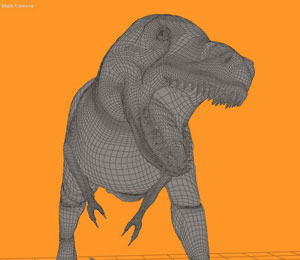
and must be modeled in a proper 3D modeling
program. It's called modeling because you build up your 3D object by inserting and modifying
basic 3D shapes rather than drawing with lines.
If you haven't modeled or created 3D shapes on a 2D computer screen before it will take time
to get used to this process. You have to learn to use computer graphic tools for manipulating
objects and surfaces if you are unfamiliar with them.


3D CAM
Now that you have your 3D model you will need a toolpath. You have your 3D model,
which defines the shape that you want to cut but it doesn't tell your CNC tool how to cut
the shape out. The 3D model doesn't know the size and type of cutter you will need to use, what directions you want to use to cut it or how tight you want the resolution.
So now you need to bring your 3D model into a 3D CAM or tool-path generating program (meshCam) to create
the part file that tells your machine how to cut the shape out.
This is where the 3D CAM program comes in. You set up how you want to cut the part in this
program.
- You lay out the part on the material.
- Once you know the cutter size, you define the resolution and direction of the cutting passes.
Some other things you can do in CAM programs are creating separate roughing and finishing
passes and defining a machining border around a irregularly shaped part.
Information on 3D Router Bits
The ball-nose bit which is tapered to 1/8th" is great for
3D work. Once you have cleared the initial path you can use the ball-nose cutter to remove
small amounts of material on fast passes back and forth across the material. This method
creates smooth and intricate surfaces.
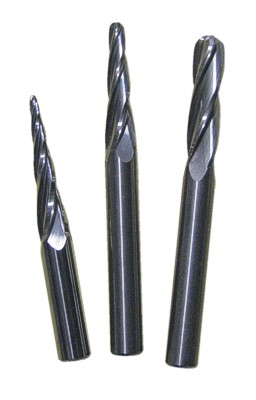

You, of course, have to choose the program you want to use for your 3D work. The standard is
combining 3D and CAM which brings something more unique and creative to the job. Many cabinet
designers, sign makers and furniture builders who use CNC Routers are very interested in
intuitive methods for carving and sculpting and for enhancing their work with 3D relief carvings.
Alternative to 3D Modeling Yourself
You may consider having the 3D design and modeling work done by other resources, such as
CNC-ready dimensional clipart

or having custom models made to your specifications. Email us
Typically when you get 3D clipart files you need to bring these files through a 3D tool
path generating program.(MeshCam) The problem with the generic 3D models on the web is that most
of them were created for purposes other than 3D machining. They are often too low a resolution
for smooth carving and many have errors that make machining difficult. Often times the models
are not suited well for scaling to different sizes. A good model has enough detail to
be cut in small or very large sizes.
We have solved that problem here at makecnc and supply models for your projects right here in our store or if you can't find what you need you can request custom relief models to be made and we will try and produce what you are looking for at a reasonable cost.
Digitizing your Model
Return to Top of Page
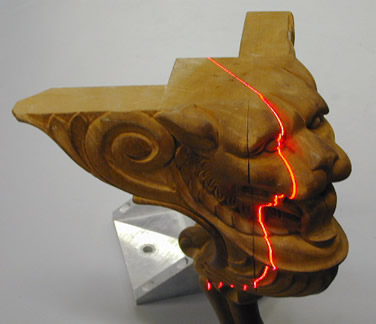
Digitizing can do some truly amazing things. A great way to produce 3D shapes without software
is to digitize an existing object or part using a digitizing probe or laser scanner. You can use a digitizing
probe to produce the 3D shape of a part, or you can probe to get the 2D outline of a part.
The probe is just a switch that is triggered when the tip of the probe contacts the surface
of your sample part. When digitizing your 3D part by probing your machine will move the
probe tip in a raster pattern. Through this it will contact and record the position of
each contact in order to reconstruct the part shape for cutting. The control software you use
has probing functions that allow you to save two types of files. You can save a part file of
instructions that is ready to cut at the end of the probing process.
Also, if you need to do some modifications to the shape before creating your final file, you
can save a file of 3D points. You can also save a file of polylines that you can use directly
as a sole entity within your 3D software.
You can also process the 3D points into a 3D surface file using the "probe to surface" virtual
tool in your software. You can then do more editing by bringing your creation into your 3D
modeling software.
Probed parts can actually be scaled in 3D CAM programs to make your object larger or smaller.
Of course, you don't even have to deal with software if you don't feel up to the task.
You may have to send it to someone to modify your design. There are even digitizing services
you can go to as well if you don't want to go down that route yourself. It's really all up to
you.

So you want more complicated things to do ! ?
Of course our discussion wouldn't be complete without mentioning working in 3D in four, five
or more axes.
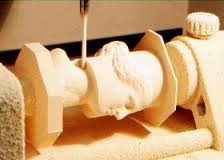
Most of the CNC woodworking tools you use are 3 Axis tools, which move a cutter
in the X, Y and Z axis. These tools machine or carve in 3D by moving the tip of the cutter in
these three axes, usually with a back and forth motion (rastering) in the X and Y axis and a
simultaneous up and down action in the Z axis. The cutter itself remains in a fixed vertical
orientation. So the cutting is done in essence by the portion of the cutter that's in contact
with the material. This is called 3D relief machining. It doesn't allow for 3D shapes that
have ledges or a shape that needs undercutting but it does give you 3D shape. It also doesn't
allow for any kind of cutting or machining that can't be done from vertically above and
perpendicular to the X-Y plane. You have to use another method if you are doing 3D work that
requires machining from the side or bottom.
Some 3D programs will generate coordinated toolpaths for machining an object from two or
four sides. Then you can accomplish the machining effect that requires machining from the
side or bottom. You can accomplish this sort of effect with slicing techniques or by rotating
the object and machining from different angles. The only problem is that this solution doesn't
fix the problem of moving the cutter around to the side or underneath.
This is where you require more movement capability so you need to add more axes of motion or
rotation. That way the orientation of the cutter can be changed, which allows more accurate
and efficient 3D shaping. Then your products can have far more shape and contour.
Having more axes also allows cutting into a part from the side as well as diagonal drilling.
Having a 4th axis rotary indexing head allows machining parts in the round. This makes the
rotation of a part fourth axis control, which mean you can profile objects just like you can
with a lathe but you have the added bonus of doing ornamental turning and free-form carving in
the round as well.
All in all, the fourth axis is a very freeing way for you to accomplish projects of any kind.
see CNC wrapper in our software dept for 4 axis software


|
